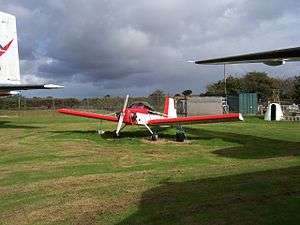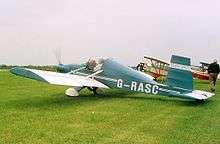Evans VP-2
| VP-2 | |
|---|---|
 | |
| Evans VP-2 G-BTAZ preserved at the City of Norwich Aviation Museum in Norfolk, England | |
| Role | Homebuilt aircraft |
| National origin | United States |
| Designer | William Samuel Evans |
| First flight | 1971 |
| Status | Plans available |
|
| |
The Evans VP-2 is a development of the Evans VP-1 Volksplane, both of which were designed in La Jolla California by William Samuel Evans a design specialist with the aircraft company Convair.[1]
Background
Work on the design of the VP-1, was completed between 1966 and 1968, the intention being that the design would be simple to build for a novice working at home. The design was successful, and, following a first flight in September 1968, a large number of aircraft have been constructed by homebuilders. The aircraft are powered by converted Volkswagen air-cooled engines.
The VP-1 is a single-seat open-cockpit low-wing monoplane manufactured from Spruce and plywood with fabric covered wings. Performance is typically a cruise speed of 75 mph (121 km/h) and a stall speed of 40 mph (64 km/h).[1]
Following the success of the VP-1 a two-seat variant, the VP-2 was designed and the first example flew in 1971. The VP-2 is externally similar in appearance to the VP-1 but with a 1 ft (30 cm) wider fuselage to accommodate two side-by-side configuration seats. The aircraft is 1 ft (30 cm) longer and has a 3 ft (0.9 m) addition to wingspan. The VP-2 can use any Volkswagen air-cooled engine model from 1834 to 2100 cc.[1]
Preserved examples
Specifications (60 hp engine)

Data from Jane's All The World's Aircraft 1982–83[2]
General characteristics
- Crew: one
- Capacity: one passenger
- Length: 19 ft 3 in (5.87 m)
- Wingspan: 27 ft 0 in (8.23 m)
- Wing area: 130 sq ft (12 m2)
- Airfoil: NACA 4415
- Empty weight: 640 lb (290 kg)
- Gross weight: 1,040 lb (472 kg)
- Fuel capacity: 14 US gallons (53 L)
- Powerplant: 1 × Volkswagen air-cooled engine 1,834 cc flat-four, 60 hp (45 kW)
Performance
- Maximum speed: 100 mph (161 km/h; 87 kn)
- Cruise speed: 75 mph (65 kn; 121 km/h)
- Stall speed: 40 mph (35 kn; 64 km/h)
- Never exceed speed: 120 mph (104 kn; 193 km/h)
- Rate of climb: 700 ft/min (3.6 m/s) (pilot only)
References
| Wikimedia Commons has media related to Evans VP-2. |
- Taylor, John W. R. Jane's All The World's Aircraft 1982–83. London: Jane's Yearbooks, 1982. ISBN 0-7106-0748-2.